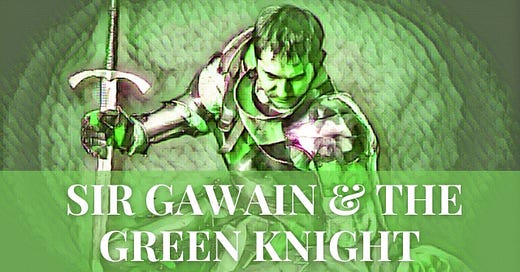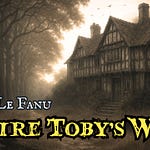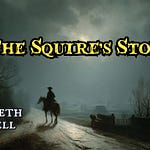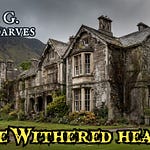Sir Gawain & The Green Knight
Sir Gawain and The Green Knight is the original Christmas Ghost Story. Or technically a supernatural story set at Christmas in the kingdom of Logres ruled by King Arthur. It's pretty gothic.
This is a prose translation of a Middle English poem called Sir Gawain and The Green Knight. The translation by Jessie Weston was published in 1898 and though it is certainly not Middle English she has left enough archaic words in to keep that flavour.
Jessie Weston herself was born in 1850 in Surrey, England, the daughter of a tea merchant. When she was young the family moved to Bournemouth off England’s south coast and she began writing there. She studied in Hildesheim in Germany and in Paris and at the Crystal Palace School of Art in South London.
She was most famous for her studies of Arthurian romances and the Grail legend where she put forth the ideas that the material was actually pre-Christian and pagan in origin. T S Eliot’s The Wasteland was influenced by Weston’s Arthurian studies.
The Green Knight as it stands was composed no later than the end of the 14th Century (the date of the manuscript) and may be much older. The language is Mercian influenced Middle English, probably from Lancashire. The boundary between Mercian and Northumbrian Old English runs through Lancashire and its dialect is influenced by both, but South Lancashire and Cheshire have Midlands’ such as pronouncing the ‘g’ in ‘king’ and ‘thing’.
If you’re interested in Old English dialects, check out Simon Roper’s Youtube Channel for a real treat.
The poem shows signs of oral storytelling with the rich, detailed descriptions that run in sequences and would probably delight an audience as they were elaborated.
The themes are of honour and courage, as befitted the courtly audience, but also of love and fashion, which traditionally interest ladies. Tricky subject these days, but that was the established view for centuries. Things change. I for one embrace change, while I mourn what it lost. I’m a bit like the VoiceOver by Galadriel at the start of the Fellowship of The Ring movie.
There are folkloric features which Weston perhaps emphasis because she was interested in them: He bears a holly bough to symbolise life and rebirth. He pole vaults over water as fairies can’t normally cross running water. The bargain is for a year and a day which is in all good fairy tales.
The motif of the talking head appears again and again in Celtic stories: Bran the Blessed, and Bricriu’s Feast from the Ulster Cycle where the beheading challenge is seen. Of course the severed head is seen on a platter in the Perceval/Parsifal/Peredur Stories.
The old lady in the castle is the famous with Morgana La Fee.
“I trow” is “I think” or “I believe”
“In sooth” is “truly”, “really” ‘fo sho’
“Wit, wot, witen’ are ’to know’ . So “ I wit” is cognate with the German “Ich weiss” or the Dutch “ek weet”
“List” is “like” or “please” “As he may list” “As he pleases”
“Welkin” is sky.
“Hearken” is “hear, or listen to”
Going through the recording as I edit, it strikes me that perhaps the green lace on the axe is the one that Gawain later gets from the lady and transpires to have been the knight’s. It was the magic of this lace that allowed him to survive the blow. Not sure why I didn’t figure that before. This is just what a modern author would be: place an item and bury it in detail so its significance isn’t grasped until much later.
It’s mainly showing not telling too. We get some insight into Gawain’s thinking, but mostly the situations are simply described and we infer internal motivations and ruminations from what we hear. Described.
I also think it’s unfair of the Green Knight to chide Gawain for cowardice, comparing his fearlessness when faced with the axe. The Green Knight knew he had a magic item that would protect him, so of course he wasn’t scared. Unfair, I say. Unfair.
You will note that when he leaves North Wales he crosses into the “Wilderness of Wirral”. I just did a members only story but Ramsey Campbell called “Again” which takes place in the wilderness of Wirrall, but a good five to six hundred years later. Comparing the two stories, it sounds like not much has changed.
Mind you, the geography doesn’t match. The Wirral isn’t high moorland and mountains with valleys. That is much more likely to be my own country of Cumbria or if he veered east into the Pennines and Yorkshire Dales.
Gawain thinks the lady of the castle is fairer than Guinevere. Guinevere is his auntie. He doesn’t think much of Morgana La Fee either. She’s also his auntie.
The comely lady of the castle tries it on with our Gawain. Even at the end she tries to tempt him with a fabulously expensive ring. He’s not a gold digger though and he refuses. She offers him her girdle. I suspect that girdle is not worn as close to the skin as a modern girdle or Gawain surely wouldn’t have accepted it, honest and pure as he is.
In fact he is only swayed to take it because she says it is magic and will protect him. His virtue sags a bit here, but only because he loves his life and who can blame him for that? Certainly the Green Knight doesn’t.
I know I have a lot of animal lovers in the audience for The Classic Ghost Stories Podcast and I fear they will quail at all the hunting. It is interesting how times change as I often muse. The huntsmen feel no sadness at the killing of a beast, and don’t think there’s anything unfair or wrong of setting a forty hounds, fifty horses and a hundred men on one lone fox. They are glad when they kill the animals and have a right good day of it.
Sins change, don’t they?
After being tested again by the squire, Gawain leaves to find the green chapel or the sunkenkirk perhaps. It sounds like an ancient burial mound to me, the sort like West Kennet barrow or some at Kilmartin in Argyll. I did a short video about Long Meg and at one point there were barrows there.
If You Appreciate The Work I’ve Put In Here
If You Appreciate The Work I’ve Put In Here
You could buy me a coffee
Become a Patron
https://www.patreon.com/barcud
And you can join my mailing list and get a free audiobook:
Music By The Heartwood Institute















Share this post